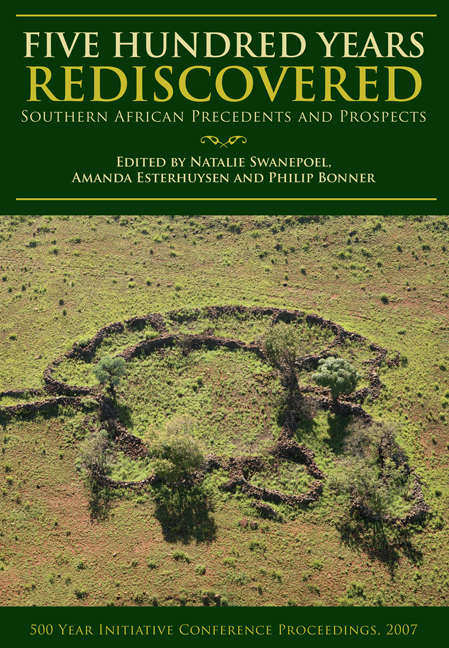Book contents
- Frontmatter
- Contents
- Preface
- 1 Introduction
- Section 1 Disciplinary Identities: Methodological Considerations
- 2 Historical archaeologies of southern Africa: precedents and prospects
- 3 South Africa in Africa more than five hundred years ago: some questions
- 4 Towards an outline of the oral geography, historical identity and political economy of the Late Precolonial Tswana in the Rustenburg region
- 5 Metals beyond frontiers: exploring the production, distribution and use of metals in the Free State grasslands, South Africa
- 6 deTuin, a 19th-century mission station in the Northern Cape
- 7 Reinterpreting the origins of Dzata: archaeology and legends
- Section 2 Material Identities
- Section 3 ‘Troubled Times’: Warfare, State Formation and Migration in the Interior
- List of contributors
- Index
5 - Metals beyond frontiers: exploring the production, distribution and use of metals in the Free State grasslands, South Africa
from Section 1 - Disciplinary Identities: Methodological Considerations
Published online by Cambridge University Press: 30 May 2019
- Frontmatter
- Contents
- Preface
- 1 Introduction
- Section 1 Disciplinary Identities: Methodological Considerations
- 2 Historical archaeologies of southern Africa: precedents and prospects
- 3 South Africa in Africa more than five hundred years ago: some questions
- 4 Towards an outline of the oral geography, historical identity and political economy of the Late Precolonial Tswana in the Rustenburg region
- 5 Metals beyond frontiers: exploring the production, distribution and use of metals in the Free State grasslands, South Africa
- 6 deTuin, a 19th-century mission station in the Northern Cape
- 7 Reinterpreting the origins of Dzata: archaeology and legends
- Section 2 Material Identities
- Section 3 ‘Troubled Times’: Warfare, State Formation and Migration in the Interior
- List of contributors
- Index
Summary
Introduction
The grasslands of the Free State area (Fig. 5.1) are part of the southern Highveld of South Africa. This region is mainly composed of an elevated grassy plain which inclines smoothly from an elevation of 1 200 metres in the west to over 1 800 metres along its eastern margin (Wilson & Anhaeusser 1998; Maggs 1976; Mucina & Rutherford 2006). The area is roughly delimited by prominent natural features: the Vaal River on the northern and western frontiers, the Drakensberg escarpment at the eastern boundary, with the Caledon Valley and its confluence with the Orange River forming the southern limit (Maggs 1976, 1980). Historical and archaeological work has revealed that various peoples continuously occupied this area in the last 500 years (Arbousset & Daumas 1852; Breutz 1953; Legassick 1969; Maggs 1976; Huffman 2002). Their activities on the landscape left behind clearly defined settlements and items of material culture which enable the reconstruction of their life ways and time of initial occupation in this area (see Maggs 1976).
So far, the archaeology indicates that the first Iron Age groups settled in this region around the 15th century. Maggs (1976) suggested that these early settlers may have been ancestors of the Sotho-Tswana who radiated from the so-called Bankenveld axis. Recent thinking has, however, added another dimension. Huffman (2007), for instance, has argued for a Nguni identity for the so-called Fokeng peoples. Whatever the case may be, it is clear that this region was an open frontier through which different groups trickled in and out of over time (Maggs 1976; Huffman 2007). This set the stage for the interaction of groups such as the Sotho-Tswana, Nguni, and hunter-gatherers living on the south-western margins.
When compared to the northern Highveld and the KwaZulu-Natal area, the southern Highveld and in particular the grasslands of the Free State were occupied at a fairly late stage by Iron Age farmers (Huffman 2007; Boeyens 2003; Maggs 1976, 1980). The former have long sequences of Iron Age occupation dating back to the first millennium AD whereas the initial occupation of the Free State grasslands did not take place until the 15th century (Maggs 1976).
- Type
- Chapter
- Information
- Five Hundred Years RediscoveredSouthern African precedents and prospects, pp. 87 - 102Publisher: Wits University PressPrint publication year: 2008

